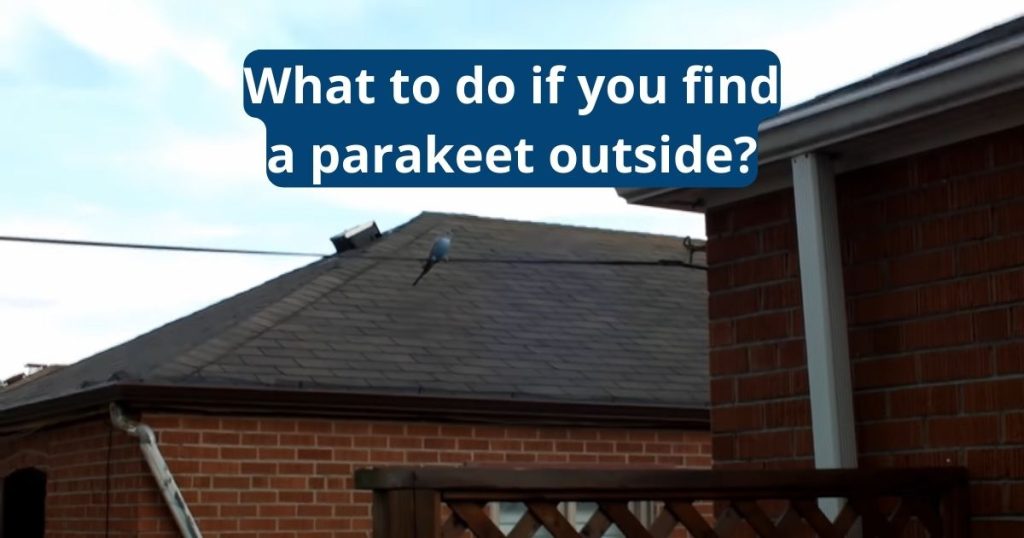What to Do If You Find a Parakeet Outside Your Home?

Many birds are tamed enough that talking to them can help lure them over. You might ask a friend or neighbor with a similar bird to bring it over (in a safe and secure cage) while you watch from the window. Try calling its name or rattling a food container. If it doesn’t return right away, you should call a local wildlife rehabilitator.
Call Your Neighbors
It’s always a bad idea to release a pet bird into the wild, and it’s especially bad when you don’t know who the owner is. It can take months for an escaped parakeet to find its way back home, and the odds of it making it are slim to none.
Call your neighbors first to see if anyone has seen the parrot. Post “found” flyers, preferably with a picture of the bird, around your neighborhood and at local animal sanctuaries, zoos, pet stores and vet clinics. Ask the aforementioned places not to try to catch the bird but to phone you if they do.
Keep in mind that a parrot’s chances of finding its way home are increased if it is not too far from its cage when found. It also helps if the bird is not in a kitchen where multiple potential dangers lurk, including hot pans and ceiling fans, household cleaners and insecticides.
If the bird is exhibiting open-mouth breathing or gasping for air, remove all perches and place it in an empty cage, pet carrier or cardboard box. Minimize handling and stress to prevent the bird from becoming too anxious, as it may become lethargic and possibly lay an egg, which could put pressure on nerves that control the legs and cause paralysis or self-mutilation.

Call the Animal Control
It’s hard to say how far a parakeet can travel once it escapes into the wild. Ring-necked parakeets, for instance, have established populations in cities thousands of miles from their typical habitats. They’re also resourceful birds, so if they have a suitable nesting spot and plenty of food and water they can survive in non-typical habitats.
If you’re able to lure the bird with seed treats, millet spray, and other enticing foods in a safe and secure cage, you can attempt to capture it. Some parrots are tamer than others, so they may be more likely to come near you if you call them and talk to them.
Keep in mind that if the lost parrot is injured, it should be taken to a veterinarian instead of you. Injured birds that are handled too much can become stressed and sick, and they are more vulnerable to predators.
Keep in mind that during the first month following a lost parrot’s escape, they typically stay within a mile of where they were found. If the bird is healthy, it can likely find its way back home if you make enough noise and entice it with tasty foods. If the bird shows signs of being ill or dying, it should be taken to a vet immediately. Signs of ill health include ruffled feathers, discharge from the eyes and mouth, a shut-down behavior, and a rapid heartbeat.

Call Your Veterinarian
If you are the owner of a lost parakeet, phone your veterinarian. They will be able to advise you on the best course of action to take. They may suggest that you lure the bird back by placing a small cage or carrier near where it was found, filling it with food, treats and toys. You can also try calling the escaped parrot, using its name and making the noises that it usually makes when in its cage. Providing water in a bowl that can easily be reached will also be helpful.
A finger-tamed parakeet that has escaped from its cage can often be recaptured by tempting it to land on your finger with millet. However, this is only possible if it has not flown far on its first flight away from home. Once a parakeet reaches its destination, it will be very difficult to entice it back to its cage as it will have become disoriented and hungry.
If you are unable to re-capture your lost pet, call your local animal sanctuaries, zoos and even pet stores in the area and ask for their recommendations on a veterinarian. They will be able to recommend a vet who has experience with
rehabilitating wild birds. They will also be able to check if your parakeet is well and if it has any injuries that need treating.

Call the Humane Society
If you aren’t able to get your neighbours to turn in their bird, or you can’t catch it yourself, you should call the Humane Society. If they’re able to get in touch with the owner, they will likely have a good chance of returning it to its rightful home.
Alternatively, you may be able to lure the bird back into its cage by setting out his favourite food, treats and companion (if he has one). This method is best suited to domesticated parakeets who have been tamed. A similar approach works well with other small birds like sparrows, robins or doves. You can also try spraying the area with a water hose, but be careful not to use a high pressure nozzle or you could injure the stray bird.
A parakeet can survive for up to a month after it escapes, but it’s unlikely that it will find its way back home. It will probably flitter around in the vicinity of its escape, or even closer to where it was spotted.
Some feral parakeets have established strong populations thousands of miles away from where they would be naturally found. This is probably because many of them were kept as pets, escaped and have been able to breed successfully in their new environments. Ring-necked parakeets, for instance, were kept in London as recently as 1950 and now occur as far north as Glasgow in Scotland.



